Interview: Foals
At a time when British guitar music appears devoid of a credible standard bearer, Foals enter the new year with a brilliantly bold and expansive fourth album, a Brit Awards nomination and a sprawling world tour that will see them play the biggest shows of their lives.

Four albums and 11 years in, Foals stepped into 2016 with the resolution to become absolutely massive, to fill the gaping void for a bloody huge British indie band, filling arenas, headlining festivals and appealing simultaneously to beard-stroking hipsters and the daytime-radio masses.
The campaign has started well. With What Went Down – one of the outstanding albums of 2015 – under their belt, the band have scooped a nomination for Best British Group at the Brits, flying the flag for fresh, thoughtful guitar music in a category where the other contenders are Coldplay, U2, Blur, One Direction and Years & Years.
A flurry of sweaty, high-octane UK and US gigs in November and December set them up to hit the new year at a gallop with a string of Australian dates and a UK and European arena tour that swallows up all of January and February – spearheaded by a show at Wembley.
From there, they dive headlong into the global festival season, with bill-topping appearances all over Europe, Northern, Central and Southern America – all the while the stages and audiences getting bigger. The Oxford band, it seems, don’t know the meaning of the words ‘day off’.
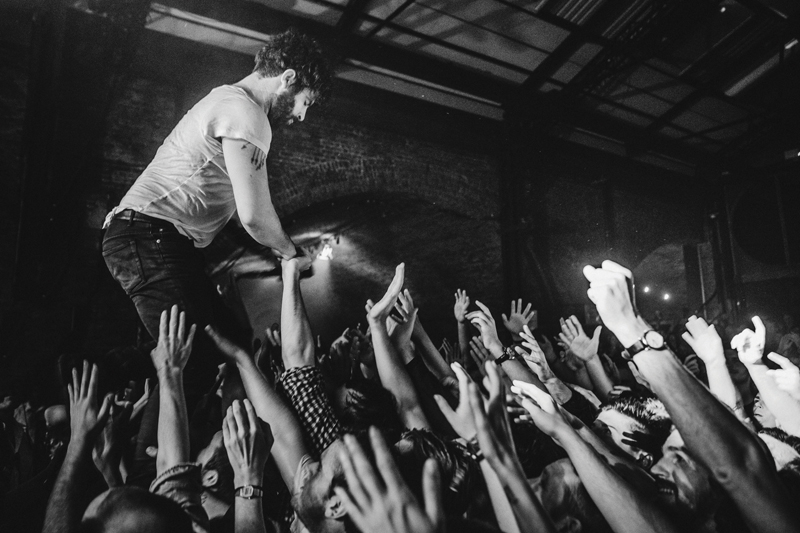
“We’re about to hit new territory in 2016,” says guitarist Jimmy Smith, who formed the band along with singer and fellow guitarist Yannis Philippakis, bassist Walter Gervers, drummer Jack Bevan and keyboardist Edwin Congreave in Oxford in 2005. “It’s going to be another step up. The live shows are getting much, much bigger this year. It’s the beginning of a new chapter for our band, and we’ll go ahead and we’ll try to absolutely slay 2016 and then see where we are.
“We’ve got these arena shows in the UK; it’s crazy, it’s absolutely nuts that our band can play arenas. Even the shows in Europe are much bigger now – they’re almost double the size. We’re starting to get big offers from festivals and it’s pretty daunting stuff.”
What Went Down, Foals’ most complete and expansive album to date, was released in August, recorded in the remote Provence village where Nostradamus was born and a tormented Vincent Van Gogh was treated in the psychiatric asylum of a monastery after cutting off his own ear.
It was one of the stand-out albums of 2015, from the psycho krautrock and menacing electric piano of the opening track through the blissful synth-splashed West Coast soul and funk vibes of Birch Tree to the gut-punchingly wistful London Thunder.
It expands Foals’ previous forays into dreamy synth splendour, without straying too far from the anthemic indie-guitar formula that earned Mercury Prize nominations for previous album Holy Fire in 2013 and 2010’s Total Life Forever.
It represents the culmination of an evolutionary path winding from the minimalism and staccato guitar of their early years, often given the umbrella label ‘math-rock’, to a wonderfully widescreen sound.
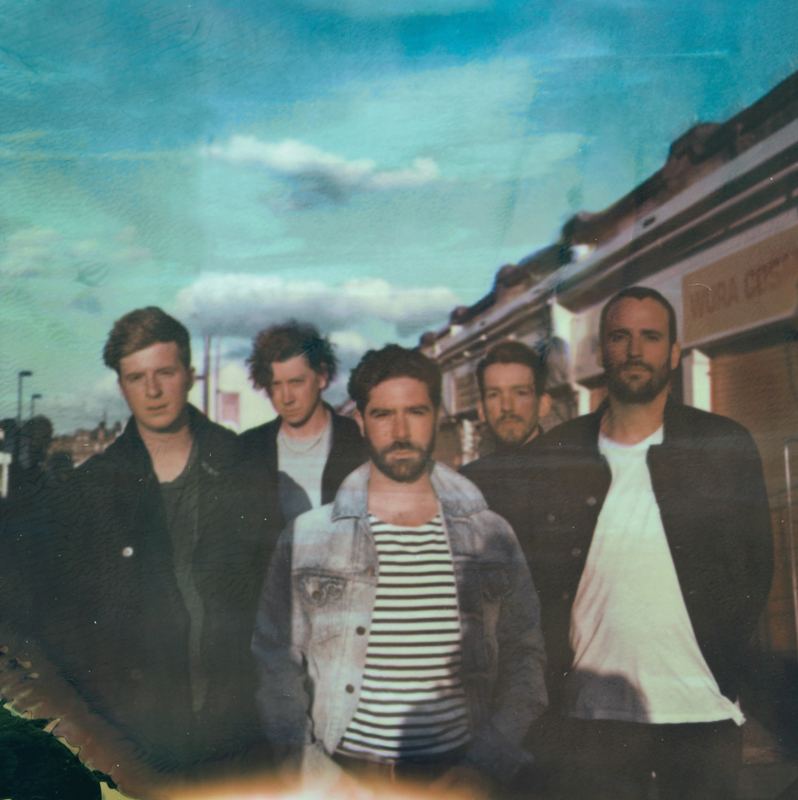
Its genesis dates back to the morning after a headline set at Bestival in 2014, at the end of another huge tour – the band have played nearly 300 dates since the beginning of 2013 – with Foals foregoing the opportunity of a holiday and marching straight into the studio.
“It was pretty similar to the writing for Holy Fire,” recalls Smith. “We’ve got a really small studio in Oxford that we rent from the council, where we always used to practise.
We thought it would be cool to have that as our HQ; it’s a tiny, tiny sweatbox of a room.
“We finished at Bestival in September 2014, took a couple of weeks off and went to Oxford and started writing. We didn’t put any pressures on whether we wanted to come up with anything straight away, but it was going pretty well so we stuck it out until January, when most of the record was finished.
“Saint-Remy-de-Provence was amazing. It was this incredible studio, La Fabrique, just outside of Saint-Remy. It’s an old mill originally, and there’s a big studio and a house to live in, run by this French couple. It’s super-homely and down to earth. It’s quite simple and I can’t think of a better way to record an album. We did it for two months and it was one of the best times of my life.”
James Ford, who produced the second Arctic Monkeys album, garnered Mercury Prize nominations of his own for work with Klaxons and The Last Shadow Puppets,
and founded the band Simian Mobile Disco, was picked to oversee the sessions.

“James came on board towards the end of writing and hammered home the point that we should probably try to finish structuring every song before we got to France, to use the studio for what it’s for – recording rather than writing music,” explains Smith. “He comes from a musician’s background – he was in bands before he started producing, and he could get more involved than any producer we’ve worked with in the past.
“He can basically play any instrument, so he learnt the songs with us and could see them from our perspective, which was pretty cool. Some producers like to keep their distance and sit behind the desk, but he was the other way round, which sped up the process. If we were stuck with a problem and couldn’t find our way out of the chorus, he already knew the song so well that he knew what the solution was.
“A lot of the synths on the album come from James. He’s an absolute genius when it comes to synth. He’s got all his modular equipment that he brings along, and he just knows how to use synths, whereas I don’t have a clue. I just mash the buttons until I get a sound vaguely like I want! I described the sound I wanted for London Thunder and James had it in about 30 seconds.”
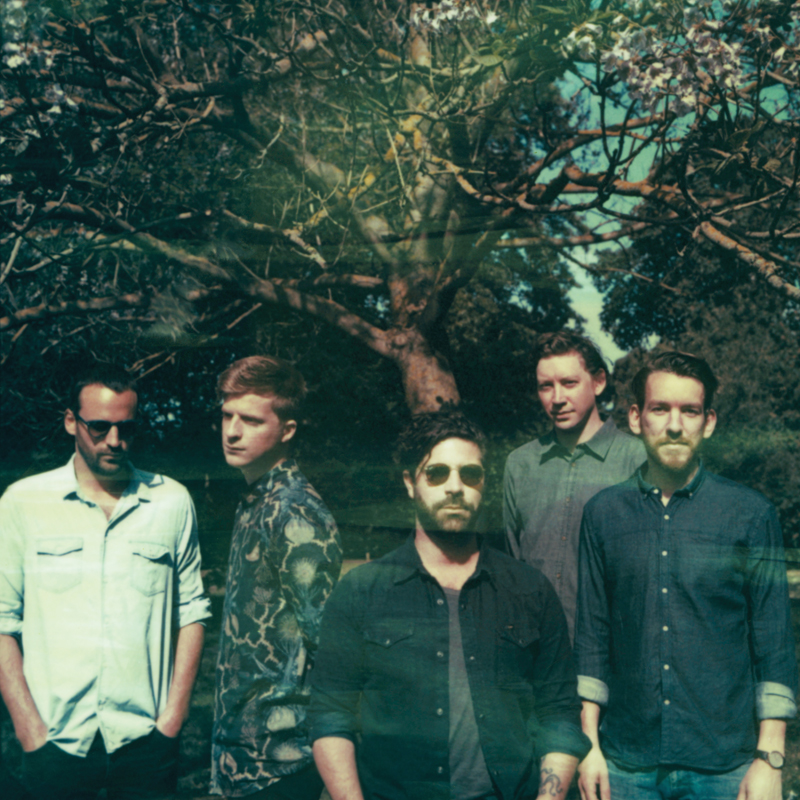
We put it to Jimmy that in What Went Down, Foals have made an album with broader appeal, where brooding Rhodes piano numbers such as London Thunder sit alongside, more immediate, ballsy indie-rock.
“We don’t just want to make a full-on rock album from start to finish,” he replies. “All the bands we love and admire are able to shift in dynamics; and when you’re listening to an album, if when you get to the end it has big mood changes and sonic changes, it feels as if you’ve gone on a journey, which to me is the point of an album.
“It feels like What Went Down finished off what we’d tried to do on Holy Fire. It feels that those two albums were similar in the writing process and what we wanted to achieve sonically, but now it’s exciting because we feel that we can do our weird album. We’ve got ourselves to a position where it feels we can do exactly what we want – which we’ve always done, but now there’s more freedom.”
Live and dangerous
When Guitar & Bass see Foals live on their pre-Christmas tour, it’s an almost religious experience, as they have a 1,200-capacity crowd united in perpetual movement from beginning to end in a way few current guitar bands we’ve watched can.

At times, it has the same sense of communion as live dance music, at others it’s pure rock ’n’ roll. Yannis rips fuzzed-up solos from his Travis Bean guitar, stood atop a speaker stack, head jammed into the PA, while Smith moves between guitar and a Rhodes piano that he runs through a pair of Fender Bassmans. It’s easy to see why they were voted Q magazine’s best live act in 2013, and nominated for the same prize by NME in 2011 and 2013.
“We always try to give it everything we’ve got because that’s how we grew up, and every band we loved when we were young it seemed evident that they treated every song as being as important as the last,” says Smith. “We’ve been released back onto the road now and it’s an incredible feeling playing a show, especially with our crowds – I feel like we’ve got the best crowds out there.”
“It’s kind of the ongoing joke in the band now that I’m officially the rhythm guitarist,” laughs Smith. “But I think that’s bad-ass, as I like rhythm guitarists. Yannis handles the solos – we’ve actually got solos now, which is weird. They sort of crept in without us noticing. I don’t think I’ve played a solo in my life – I don’t know how to do it and I’d probably get terminal stage fright.”
Jimmy’s Jazzmasters
Smith’s Jazzmasters are all supplied by Fender, and the company has even made him his own bespoke range with original colours and matching headstocks.

“I’ve had quite a few Jazzmasters from Fender, all Mexican Classic players, and I had a problem with the strings coming off,” says Jimmy. “We played Lollapalooza in Chicago. It was my birthday and they gave me a Mexican Sunburst Jaguar and told me it was specifically designed so I could play it really hard, and I plugged it in on stage, and on the first note the three bottom strings all came off! Now my guitar tech is on it and sorts it all out for me.
“My guitars are super-cool. I requested that I repaint some of the guitars Fender give me, and wanted to paint them the original surf colours – Sonic Blue and Surf Green – and Neil [Whitcher, Fender’s European head of artist relations] said ‘how about we just make them for you?’. I’ve got four now – two of each. It’s pretty great!
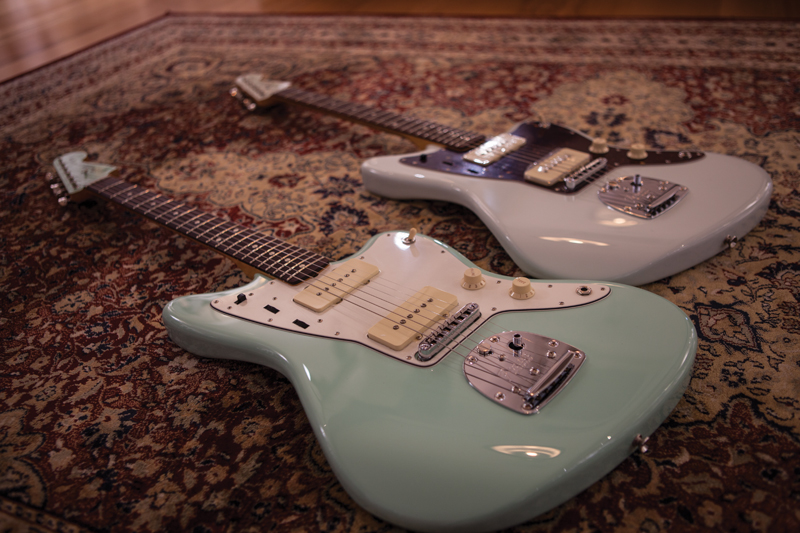
“I like the fact that Jazzmasters are pretty loud. I always play them on the neck pickups, and they’re big and warm, and for the studio they’re pretty versatile. You can get a lot of different sounds out of them. They’re nice to play, and I like the size of the body and the way it’s cut. If I’m playing it every single night, sometimes I struggle with other guitars. I used to really want a Mustang but I just couldn’t get to grips with the body. It’s strange, the Jazzmaster just seems to totally suit me… and I really love Sonic Youth. I grew up looking at those old beaten-up Jazzmasters.”
“Jimmy has been playing Fender Classic Player Jazzmaster Special guitars since the Holy Fire album cycle,” says Whitcher. “He was looking for a robust touring instrument, the Classic Player suited him well due to the nature of the tune-o-matic bridge and the break angle over the saddles being increased, as the trem system is moved slightly closer to the bridge than on vintage and traditional Jazzmasters.
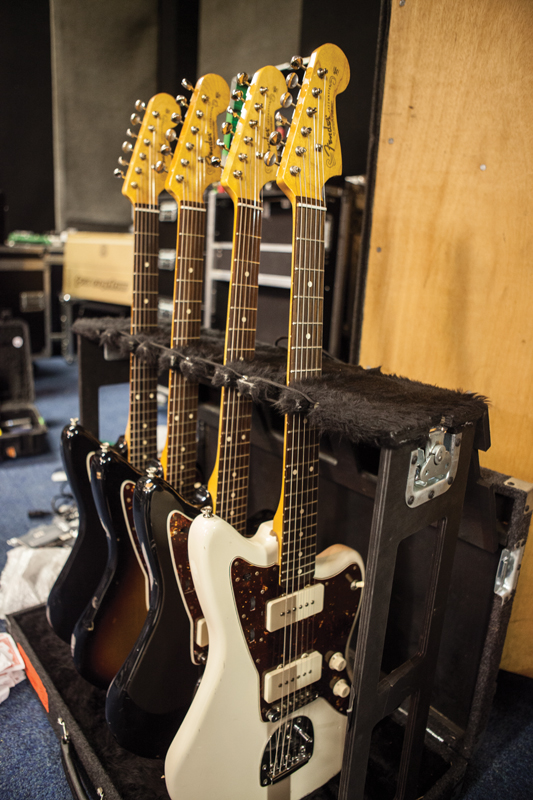
“He’s pretty hard on his guitars, I’ve seen them go through stage ceilings, strung up on lighting rigs, even being kick flipped… amazingly they always seem to be able to put the guitars back together.
“For the new album campaign, we decided to do a couple of custom colour guitars for Jimmy to take out on the road – he wanted matching headstock models, which are not available in the Classic Player series, so I commissioned the factory in Ensenada to build him a Surf Green and a Faded Sonic Blue (with tortoise shell guard), both are Classic Player Jazzmasters, both with matching headstocks.”
Smith’s playing journey began playing classical guitar with his mother, before he bought his first electric – a Mexican Strat – on Denmark Street and first heard the music of Nirvana and Radiohead, who went to the same Oxfordshire school he attended along with Gervers.
“Jonny Greenwood single-handedly changed the way I thought about guitar,” he says. “It’s completely unconventional and he’s got a really good balance between using amazing effects and being able to make his guitar sound like anything – a synth, a violin or god knows what… or using a pound coin as a pick and it sounding incredible. Rhythmically he’s amazing, too.”
Like Greenwood, Smith has retained his love of Fender guitars, preferring Jaguars and Classic Player Jazzmasters, while the Radiohead man mainly uses a Tele or a Starcaster. Smith’s currently playing Limited Edition Olympic White, Black and Sunburst models and Surf Green and Faded Sonic Blue guitars specially made for him by Fender, through an Orange Rockerverb head.
Fender provided the amps for the album sessions, too – a ’68 Custom Vibrolux, ’65 Deluxe Reverb, ’68 Deluxe Reverb, ’65 Super-Reverb and Vibro-King and ’65 Princeton.
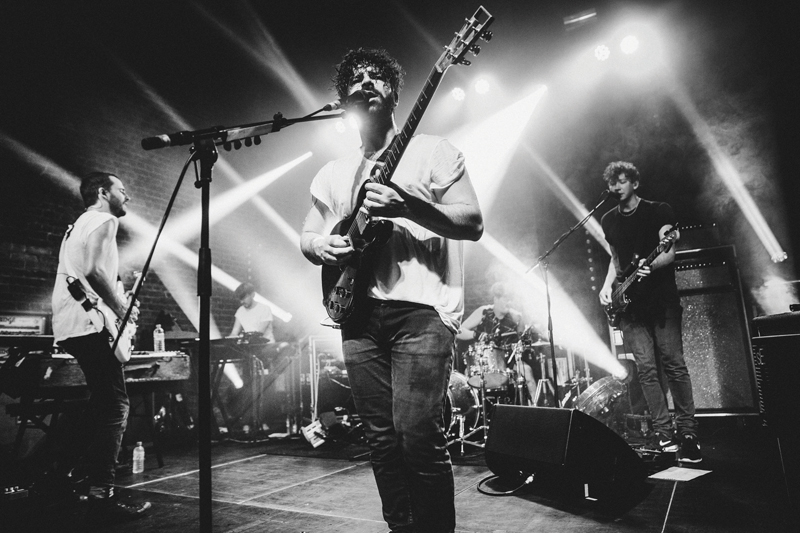
Yannis plays exclusively guitars made by the now-deceased Californian luthier Travis Bean. The distinctive aluminium-necked guitars with their capital T headstock cutaway are a foundation of the Foals sound.
“That’s the only guitar he uses,” explains Smith. “They are pretty bloody good. He uses it with a Hiwatt, which is one of the best guitar sounds ever for a powerful clean sound, and I think the key with the Travis Bean is it has an aluminium neck mounted all the way to the back of the body, and the pickup sits directly on the aluminium neck – and that just does something to the sound.
“It’s pretty full and rounded, but not trebly. It’s the dream clean sound as far as Foals are concerned. I’ve been trying to match it ever since and it’s a bit of a nightmare for me.”
Delay, too, is fundamental to the Foals blueprint, with the two guitarists’ syncopated rhythms dancing in and out of each other.
“We used to just use the [Boss] DD-3, but it got a bit complicated trying to change the delay time between songs,” says Smith, “so for the last two albums we’ve used the Strymon TimeLine, and it’s really good because you can programme in the BPM of the songs, and then you just scroll through them. They’re amazing pedals and I haven’t really got to grips with what you can actually do with them – they’re capable of anything and pretty much the best delay pedal you can get.

“A couple of months ago, I put my old DD-3 back on the pedalboard because it’s so much easier to manipulate. It’s child’s play compared to the Strymon. I’ve got a [Line 6] DL-4 that I just use for the looper, and that’s an awesome pedal, too. Dave Sitek from TV On The Radio, who made our first record, showed me what you can do with it, with the half-time looping and reverse looping… I use that at the end of the chain.
“I use the Boss RV-5 on the modulate setting for Spanish Sahara [from debut album Total Life Forever] and I really like Earthquaker Devices, because they’re really fun. I use their Rainbow Machine, which is a modulated, sort of nightmare pedal that bizarrely makes a sound like a rainbow! You can tune it in and it changes pitch and does these big sweeps and is a soundman’s nightmare – it’s totally unpredictable. I used it in the studio on [What Went Down’s epic closing track], A Knife In The Ocean – that big swell that leads into every chorus is that pedal.”
New Jersey husband and wife outfit Fuzzrocious Pedals supply Smith and Yannis with their enormous fuzz tones.
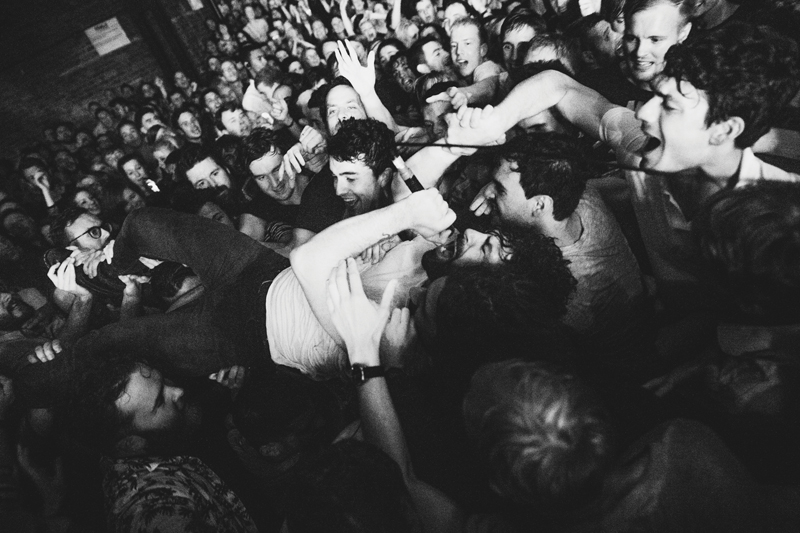
“I’ve got two fuzz pedals from Fuzzrocious. They’re a super-small company and their son hand paints all the pedals,” says Smith. “We’ve been using them since the beginning of Holy Fire and we’ve been following his son from basic splurges of colour through to stick men on the last album. I think he’s finally learning about painting people now! They’re really cool, and I have no idea how to use them because there’s no indication of what any of the knobs do. They used to be really big and we got him to make some compact ones, but he neglected to put any kind of signage on them.
“You can flick a switch and lose loads of bottom end. I’ve got two and they’re EQ’d differently, so one’s quite trebly and one’s really growly. I’ll use the trebly one on [Holy Fire lead single] Inhaler and then in the chorus switch over to the growly one. We both use them, and because of our different guitar and amp set-ups they sound totally different. The combination of all those fuzzes really makes a sort of dream fuzz sound.”
Our time with Foals draws to a close as they leave for another airport, another continent and another chapter in the evolution of one of the best bands to emerge from these shores in the past decade. As they prepare to spend most of the next year seeing the world through airport, tourbus and hotel windows, we wonder if they still enjoy life on the road.
“I love touring, and it keeps getting better,” replies Smith without hesitation. “We’re used to it now and we’re experienced. We’ve been touring for a decade and been around the world quite a few times. We know what we’re doing now. You can recognise all the signs of on-tour depression and that kind of thing, and fight it, we all look out for each other and we’re really excited.
“It�’s been a slow, gradual build-up for us. If it had happened any quicker it would have felt weird and maybe disingenuous. We’ve built this mixture of different fans, and I wouldn’t want it any other way.”
